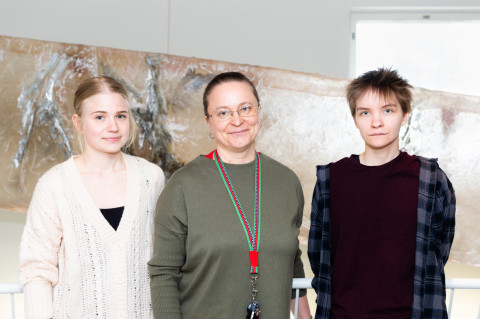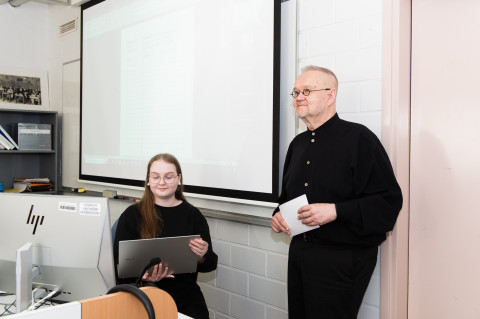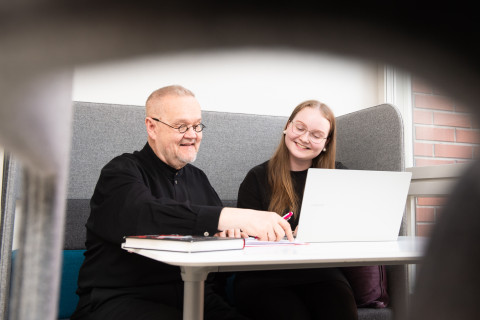When revitalising a language, keeping its vocabulary up with the times is important.
For a long time, the Karelian language has been a colloquial language, one that is mainly spoken in homes and among family. And since many speakers of Karelian are elderly, the language is somewhat old-fashioned. The University of Eastern Finland has, for a couple of years now, been working to revitalise the endangered Karelian language, including providing support for vocabulary work. Concrete steps are currently being taken on a course dedicated to Karelian dictionary and terminology work, the main aim of which has been to provide students with tools for developing the vocabulary.
“This group has been exceptionally active and, thanks to lively discussions on vocabulary, all of our lectures have run overtime,” says Postdoctoral Researcher Susanna Tavi, who in charge of the course.
Students are currently coining vocabulary related to gastronomy, pharmacy and art, among other things. Words are first considered and discussed in small groups, after which they are presented to all students on the course. Working together, the group then analyses the words and pays attention to how they work in spoken language.
Support is, of course, always available from teachers of Karelian, including from Natalia Giloeva, who has also taught the Karelian language at Petrozavodsk University.
“The first thing our students do is check whether the word they are looking for can already be found in a dictionary of the Karelian language. If so, they have to think about whether the word should be reformed if it doesn’t fit into the desired context, and they’ll also think about whether the word should be a compound or a combination of words. They can also turn to other languages in the same language family, such as Estonian and Veps.”
Students also use various search engines to find parallel texts. Parallel texts are texts that resemble the desired translation as much as possible in their topic and style.
“Finally, the word will be adjusted in terms of its ending, i.e., students have to think about whether to end the word in “i” or “u”, which are forms typically found in the Karelian language. And, of course, the word must be grammatically correct,” Tavi says.
Students often come up with several different translations, and the group works together to find the best one. If the word is very topical, a decision must be reached fast since new words are constantly needed, for example, for Karelian-language radio news broadcasts by the Finnish National Broadcasting Company, Yle.

Gender neutral forms to begin with
Although a lot of time and effort is given to coining new words, they don’t always stick. Sometimes, however, a new word catches on right away, as happened with the words “baby box” and “gibberish”, for example.
“Both of these words have been coined in collaboration with language users. People interested in the Karelian language are very keen to participate in vocabulary work, and it is also easy to reach them through social media,” Giloeva says, delighted.
In Karelian, the baby box is now known as yskyniekanvakku. Finding a Karelian equivalent for the word was ultimately a long process. According to Giloeva, a direct translation from Finnish into Karelian would not have worked. This is why the translators did what translators do – instead of translating the word, they conveyed its meaning.
According to Milla Tynnyrinen, who coordinates the language revitalisation project, it has been easy to look beyond gendered forms when coining new words for Karelian.
“For example, the Karelian language didn’t have an equivalent for ‘everyman’s right’, which is a gendered term in Finnish, tying this right to a specific gender. It is challenging to give new life to an old term, but in a gender-neutral form. In Karelian, we can now come up with equivalents that are readily gender neutral.”
And indeed, “everyman’s right” in Karelian is now jogahizen oigevus, “everyone’s right”.
In Finnish, some words are tied to gender. In Karelian, we can now come up with equivalents that are readily gender neutral.
Milla Tynnyrinen
Coordinator of the Karelian language revitalisation project
Creativity, courage and humour
At the University of Eastern Finland, the Karelian language can also be studied via the Open University, which is popular among people of all ages interested in the Karelian language. The teachers say that students taking courses via the Open University are very enthusiastic and motivated about the language.
One of these students is Hannu Lappalainen, who on the course wanted to focus on food vocabulary. He is currently looking for suitable translations for such terms as “to sauté” and “a sorbet”, to pick a few examples.
“Of course, people have always eaten food, and the basic food-related vocabulary exists also in Karelian. However, words used in recipes and restaurant menus are missing.”
Lappalainen’s pair in the small group is Elena Rapa. She majors in Swedish, but has taken Karelian as a minor, progressing all the way to the advanced level.
“I, for my part, set off to create vocabulary for scientific writing. This stems from a genuine need to write an abstract for a scientific article in Karelian, and I noticed that the existing vocabulary is incomplete for that purpose. In fact, I’ve pretty much had to start from scratch,” Rapa says.
Both the students feel that it takes courage and creativity to create new vocabulary.
“One mustn’t be too set in one’s ways, and humour can’t be forgotten, either,” Lappalainen says.

Language revitalisation gives hope
In addition to studying languages, both the students confess to being language activists. The Karelian language has, thanks to family history, played a role in Rapa’s life already before. She’s known some of the words used in her family to be Karelian, but with her studies progressing, she’s learnt to recognise more of them. Lappalainen, on the other hand, says that his motivation to study stems from a love for the Finno-Ugric languages, and his earlier knowledge of Estonian, among others, has helped with the Karelian language.
Rapa says that studying the Karelian language has inspired her to revitalise the language also on leisure time.
“I want to make the language visible by posting about it in my blog and by translating posts on social media into Karelian.”
People speaking the Karelian language aren’t tied to any one geographical location. The language is spoken in both Finland and Russia, and even within Finland, descendants of resettled Karelians are scattered across the country.
“The ability to work online has been a lifesaver for our revitalisation efforts, making it easy for people speaking the Karelian language to keep in touch despite geographical distances,” Lappalainen and Rapa say.
Both of them are eagerly looking forward to the next Government’s possible aid for language revitalisation. There is hope, because among the new MPs, there are those who during the run-up to elections signed a petition for the Karelian Language Act.
“Although there are more speakers of Karelian than the Sámi languages in Finland, the status of Karelian is much weaker, and that’s disappointing. Karelian has been spoken in Finland for as long as Finnish, but the language is not mentioned in our Constitution, and revitalisation efforts are largely underfunded. Moreover, Karelian is still often seen as nothing more than a dialect,” Rapa says.
However, the climate around the Karelian language is gradually changing. Both the students are delighted about language revitalisation becoming much more professional after the university was assigned official responsibility for it.
“It’s not all bad: there are good moments and glimpses of hope. And being involved in vocabulary work makes us feel that we are creating something permanent for the language.”



